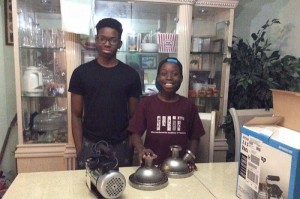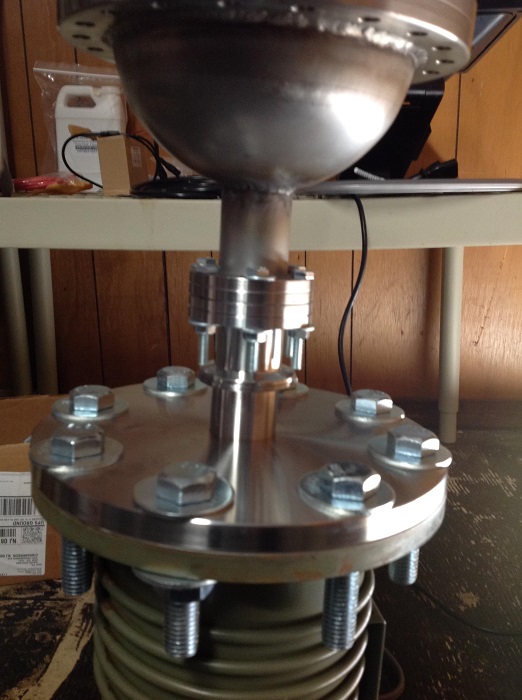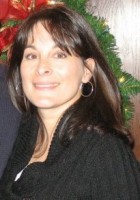Meet the High Schooler with Nuclear Aspirations

Steven (L) and Anthony (R) Udotong. Steven is well on the way to constructing a nuclear fusor, some of whose components are seen here. Photo courtesy Steven Udotong.
Steven Udotong, a 16 year old high school junior from Cinnaminson, N.J., recently made headlines as he prepares to become one of only a handful of young men or women to privately construct a nuclear fusor (a device using the inertial electrostatic confinement concept to fuse deuterium gas molecules) on his own time. ANS contacted Steven via email for information about the project, and his opinions about nuclear energy, nuclear technologies and the place of nuclear technologies in education.
How did you come up with the idea to build a fusor? That is, what was your direct stimulus to construct this type of device?
In my sophomore year at high school, I grew curious about nuclear energy after we flew by the topic in Chemistry. I decided to conduct some independent research about it over the internet and soon discovered that I could build my own "DIY" nuclear fusor. I am now inspired by the large amount of donations that I have received for my cause and I have a strong cause to finish this project as soon as possible.
Tell us a few things about building one of these that the general public will not have realized, or might find interesting.
The most important thing people should realize is that nuclear energy is not as dangerous as they perceive it to be - given that safety precautions are being followed - and that it is less harmful to the environment than the energy sources that we've been most comfortable with (coal, oil, etc).
Do you believe that students actually being able to see your device, or one like it, would give a greater appreciation of nuclear technology? What is the value of seeing something real, as opposed to just seeing a video or reading a book?
Being able to see this device in action should definitely bring a greater appreciation to nuclear technology. Just being able to see that it works and a high school student can figure it out proves that the technology is possible and not quite as dangerous as they believe it to be. The value of physically seeing something real makes it seem more personal because you can feel the environment, unlike watching a video from a couch, or reading a monotonous book.

Components of Steven Udotong's nuclear fusor project. Photo courtesy Steven Udotong.
Tell us what's wrong with energy education in the school systems today.
They really do not go into depth when speaking of energy, and completely abstain from speaking about applicable energy. This stays true unless you take an advanced class, or go to a high school with a well-funded science department. So in the end, very few high schools are educated about energy, and its source's impact on the environment.
What could be done, in your opinion, in the schools today (public schools specifically) to enhance awareness of nuclear energy and its contributions?
Schools should try to go more in-depth into this topic during chemistry since this course is already offered in most high schools. Unfortunately, my school only went over this topic for about a week, so I believe there should be some alterations made to the basic curriculum.
Where do you see yourself moving on to from this point? And, how will constructing and operating this fusor help set you on that path?
After completing the fusor, I would like to conduct some experiments with deuterium fusion and join the Neutron Club on fusor.net. I also want to enter this project in Intel's International Science and Engineering Fair. Mainly, I'd like for this to generate more awareness to sustainable energy sources for the future. Hopefully, the construction of the fusor will set me on the path to go to an engineering school, or a university with a strong science department.
Tell us a bit about your other interests. What other hobbies or pastimes do you enjoy?
I enjoy participating in school activities, namely the Multicultural Club, the Interact Club, and running Track & Field.
-------------------------------------------------------------------------------
Steven's work to complete the fusor project seems to be on the right track towards success as his internet-based crowd funding effort has reached and surpassed its original goal. We'll keep track of Steven and his efforts, and keep Cafe readers updated.
Certainly, judging by his initiative, Steven Udotong has a bright future. However, there is a need for more and better nuclear science education in K-12 schools, as noted by his comments above. We believe that students (and the world) would benefit if the U.S. educational system included nuclear science in the basic curriculum, not just merely glossed over the topic. In the meantime, in an effort to help teachers seeking to learn more for themselves and/or teach their students, the Center for Nuclear Science and Technology Information provides nuclear science materials for a variety of grade levels through its public information website at NuclearConnect.org. From Teacher Workshops (the next one is Saturday, June 10 in San Francisco) to classroom activities, the Center offers an array of games, bookmarks, posters and so much more. Please email outreach@ans.org if you have any questions about the Center's efforts or would like to attend the Teacher Workshop in June.
Knowledge is power. Let's teach nuclear science to young minds like Steven Udotong and empower them. Nuclear technology needs to grow, for the overall betterment of the planet and its inhabitants.
 Will Davis is a member of the Board of Directors for the N/S Savannah Association, Inc. He is a consultant to the Global America Business Institute, a contributing author for Fuel Cycle Week, and he writes his own popular blog Atomic Power Review. Davis is also a consultant and writer for the American Nuclear Society, and serves on the ANS Communications Committee and on the Book Publishing Committee. He is a former U.S. Navy reactor operator and served on SSBN-641, USS Simon Bolivar.
Will Davis is a member of the Board of Directors for the N/S Savannah Association, Inc. He is a consultant to the Global America Business Institute, a contributing author for Fuel Cycle Week, and he writes his own popular blog Atomic Power Review. Davis is also a consultant and writer for the American Nuclear Society, and serves on the ANS Communications Committee and on the Book Publishing Committee. He is a former U.S. Navy reactor operator and served on SSBN-641, USS Simon Bolivar.
 Linda Zec is the Online Communications Specialist for the American Nuclear Society, as well as the editor of the ANS Nuclear Cafe.
Linda Zec is the Online Communications Specialist for the American Nuclear Society, as well as the editor of the ANS Nuclear Cafe.

-3 2x1.jpg)